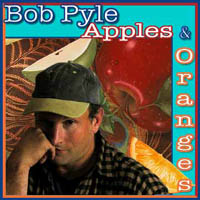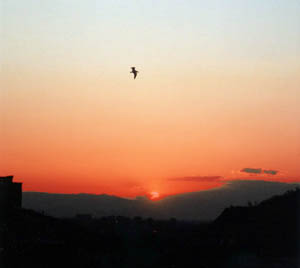I was a Fish Killer
Early Years
I first fished at age five, with my brother Greg, who is one year younger. Each of us caught a perch out of a lake in St. Paul, Minnesota. Fascinated, we watched the two perch swim around in a small bucket until first one and then the other died. I don't remember what happened to their bodies, but I know they were not large enough to eat. Perch are plentiful, and easy to hook, and are therefore considered to be a good species for practice fishing. Many members from both sides of my family were fishers, as well as hunters, trappers, and ranchers. . . . Like most children, we learned what we were taught, setting aside whatever qualms we may have felt. Our mother raised us to care for cats and dogs, and we regularly took in strays, despite housing project rules which forbade it. However, we were told that fish had no feelings, and we killed them with abandon. . . . Sometimes they were eaten, and sometimes they were simply thrown away. The most important thing was the acquisition: the victory.
In our early teens we also fished for carp. Although they are considered a "trash" species, not recognized as "game," they are much larger and fight much harder. Carp typically were left to suffocate on the shore. We were told this was good for the other fish in the lake, as carp supposedly turned the bottom to mud. Sometimes I would give a fleeting thought to whether these animals suffered as they lay gasping on the shore. Like catfish and bullheads, carp take a long time to suffocate. After a while, we would hit carps' heads with rocks to kill them quickly. Once we brought M-80 firecrackers to the lake. We stuffed one into the gill of a large carp, lit the waterproof fuse, and released him. Seconds later the water erupted in a red spray. When the muddy water cleared, we saw the carp's head, blasted away from his body. I watched tentacles of flesh sway back and forth in the current. Small fish inspected them with curiosity. For some reason we felt bad about this, although no one said anything in particular. . . .
In our late teens we got our own cars, and turned our attention to different lakes and larger game fish . . .. Often we bought large sucker minnows as bait. . . . The suckers were thrown out and suspended under a bobber. . . big enough to prevent the minnow from pulling it underwater, but small enough to be taken down by a larger predator as it grabbed the minnow. Although we were told, and wanted to believe, that fish did not feel fear or pain, we almost always knew when a predator approached the sucker. The bobber would begin to bounce and move; although the sucker wasn't big enough to sink the bobber, his or her panic was obvious. The bobber jerked, pulsed, and slowly dragged across the water as the bigger fish approached. Often the predator would only strike the sucker and let go, probably sensing that something was wrong. We would reel the smaller fish in to find him, or her, often still alive but ripped to shreds. At one point I decided that live bait fishing was cruel and not particularly "sporting," and I pursued my prey thereafter with artificial lures or dead bait. This, I felt, would be more humane.
As time went on, we increasingly often addressed matters of ethics and conservation, at least superficially. Spokespeople for fishing began talking of catch-and- release. This, they assured, would secure both the future of our victims, and the tradition of humans harassing and killing them. In catch-and-release, we would hook our prey, allow them to suffer as they fought for their lives, and then release them, hoping they would survive to endure this torture again. What we never bothered to admit was that any supposed quest for food, our supposed primary objective as hunters, played no part in our new ethic. . . . At about the same time catch-and-release became popular, there came another move to make fish abuse more "sporting." This time the ethical gurus decided that fishers should use lighter gear to fight our victims. It was of course no accident that the move spawned a whole new avenue for profit. . . . For me, ultra-light methods were a very successful method of destroying many species of fish.
Of course, using ultra-light gear condemned our victims to more suffering than ever in the name of sportsmanship. We thought it was great. A small fish could be fought not for a couple minutes, but perhaps for a quarter of an hour, half an hour, or more. As someone who invested heavily in ultra-light gear, I was able to in some cases extend my victims' misery for hours. I even wrote articles on the subject that appeared in local fishing magazines.
Coming of age
As I reached my early twenties, I continued my quest for bigger fish. One goal was to catch a fish over forty pounds. . . . When I wasn't fishing, I was either working to make the money I needed to pursue fish, planning my next expedition, or reading up on my obsession. A library book about shark fishing almost immediately convinced me to try it. Over the next few months, I made ready for a trip to the Atlantic Ocean.
At first, my conversion to shark fishing seemed to quell a fairly quiet but nagging voice suggesting that killing animals, especially those much smaller than me, was not completely defensible as a hobby. . . . In the spring of 1985 I drove to Montauk Point, Long Island, New York. I immediately found that my preparations were completely inadequate. Nevertheless, by a stroke of luck and macho stupidity, I succeeded in killing a seven-and-a-half foot, 230-pound mako shark, despite of my undersized boat and equipment. My fish story about the one who didn't get away was written up in the New York Daily News.
For the next few years I heard my story retold by those who did not know I was the human participant, and it was a real ego boost. Fishermen love to tell stories, whether their own or someone else's. Every year, the fish became larger and the boat became smaller. In truth, I had ambushed a fish who was merely seeking a meal, and subjected him to five hours of agony before killing him. For some years the mounted shark hung as a trophy on my office wall. At home were other mounted animal bodies, testimony to my insecurity, insensitivity, and willingness to kill for fun. As I look back, the whole thing seems quite macabre.
Over the next few years I went to the ocean at least twice a year, for two or three weeks at a time. I bought a new boat, made for ocean fishing, and named it the One Resolve, because of my determination to hunt and kill a rare thousand-plus-pound great white shark.
I stole the lives of uncounted victims of many species. But what should have been a killer's dream come true was somehow losing its luster over time and death. On occasion we would go night fishing for tuna offshore. Tuna are large, very strong fish, with rigid bodies. Once pulled onto the deck of the boat, they beat their tails incredibly fast and furiously. They can break a fisherman's foot. When the bite was on, the deck could literally be full of tuna struggling for life. In order to keep them still, we simply put a cloth over their exposed eye to block the light and calm them, much as you would calm a horse. This was a problem. Much like a horse? How much like a horse? I wouldn't do this to a horse. Why was I doing this? For years, I managed not to answer that question.
The Baby and the Big One
. . . . My brother and I encountered a baby mako shark next to the boat . . . Mako sharks are fearsome-looking, with large gnarly teeth and coal-black eyes that make them look as if always enraged. But this miniature version, of about twenty pounds, was just plain cute, like a lion cub trying to strut his stuff with baby growls and tiny hops, feigning attack. My brother Greg asked if he could catch the baby, and have him mounted. This was a common practice, but one that I abhorred. This was, after all, a baby. From a fisher's view, however, he was also a lot cheaper to mount, and did not require the room a large fish did to display. Initially I refused to allow the capture, but when the baby hung around, a sorry version of brotherly love won out. No effort at all was required to capture the baby. Greg stuck a dead hooked mackeral in front of him, he grabbed it, was hooked, and Greg swung him into the boat, into a fish hold. We did not shoot or even hit the baby in the head: that would ruin the mount. I don't remember how long it took him to die, but it was very long. Every now and then I would open the hatch to see if he was dead yet, and he would look at me. Sharks can move their eyes to a point, and they can and do follow activities around them. I will never forget that baby watching me as I waited for him to die. This was probably the lowest I dropped in my long history of killing.
Then came the day that a friend and I hooked into the largest mako shark I ever saw. She looked like an ICBM missile when she jumped, and my friend and I were so fearful that our legs shook. This was going to be the trophy of our lives. For the next two hours we fought and fought just to get the huge animal close to the boat. But a short time after the fish began the familiar circling around the boat that indicated the start of fatigue, the hook pulled out. Probably she had been "foul hooked," meaning hooked in the body somewhere other than the mouth. Our dreams of a "monster kill" were shattered. We fished the area for the rest of our trip, but without ever so much as seeing our "trophy" again.
When we were ready to leave for home, we were still sulking like scolded puppies. I moaned and groaned my disappointment to the marina manager, with whom I had become good friends. His response was not what I expected. He looked me in the eye and said, "Steve, I'm glad you didn't kill that fish." I was so taken aback, I said nothing. He told me that such a large mako was almost certainly a female. He said he recently learned that females had to attain many hundreds of pounds before even reaching the age of giving birth. With the mako population in serious decline, he said, we had to stop killing them. This made sense to me, even if I still wanted that "trophy."
But then he said, "I'll tell you the truth, I just don't know how much more of this killing I can take." Oh s--t. Now that nagging voice I was hearing for years wasn't just in the back of my mind any more. It was being voiced right in front me, by a friend. I didn't know what to say, except to murmur that I respected his right to his opinion. I didn't say that I was having a tougher and tougher time trying to deny this feeling in myself.
One of the last straws occurred at a most odd time. I was fishing with a friend and working companion named Rick, with whom I had taken a number of successful fishing trips in the past. We hooked a 200-pound mako shark right at the end of the day. The fish jumped repeatedly and fought hard, all of which we should have enjoyed immensely. Having brought the victim to the side of the boat, I made a good shot with my .357 magnum revolver. . . . As the beautiful luminescent blue of the mako began to turn to turn gray with death, I turned to Rick and said, "You know, I just don't enjoy this the way I used to." There. I had said it. That nagging feeling that had dogged me for so long now had a voice, and was my own. But things got stranger when Rick, his smile disappearing, said, "You know, I feel the same way." What was my world coming to?
Hegins: The End and the Beginning
I don't know how long I might have been able to ignore my awareness that I was doing something indefensible. It might have gone on for years. Fortunately, Hegins, Pennsylvania lay close to the route I took from Chicago to Montauk. On the way to my boat in 1989, I chose to stop and see the infamous Hegins Labor Day pigeon shoot. After witnessing my first pigeon shoot, my perception of my animal trophies was never the same.
. . . . Initially, it never crossed my mind that I would actually stop doing what I had done for three decades. My intention was to stop these vile pigeon shoots, and then go on with the vile things I was doing. I approached many of my hunting and fishing friends for help in fighting pigeon shoots, which as I explained, were not only unethical, but cast all of us "legitimate sportsmen" in a bad light. With the exception of my brother, none of the great hunting "conservationists" were willing to take any time away from killing to actually try to help animals.
It was about a year before I gave up blood sports. God knows how I fought to continue to kill. Leaving blood sports meant accepting a whole new set of values, and eventually coming to terms with owing a debt I could never repay. But after Hegins, it became clear that I would have to try. Greg and I buried our "trophy" victims, including my first shark and the baby mako, in a grave on our family property, next to the graves of beloved nonhuman family members. I donated the One Resolve to the Sea Shepherd Conservation Society. As I tearfully bade her good-bye, I renamed her the New Resolve, for she would now be used to save lives instead of taking them . . . .
When I first talked to activists about fishing, at Hegins in 1989, one person asked me, "Would you still fish if they had vocal cords?" I believe the answer in most cases would be no. Fishing is as popular as it is precisely because fish do not have the ability to communicate suffering as readily as cats, dogs, cows, or other mammals. But I know they suffer tremendously, just as we would if subjected to such horrendous treatment. While many people may at first be taken aback at the mere suggestion that fish can suffer, I believe society can grasp the concept. And if we can make people feel for those who cannot cry out their suffering, how much more will they feel for those who can?
—Steve Hindi
Steve is the founder of SHowing Animals Respect and Kindness (SHARK), an organization that opposes all cruelty to animals in the name of sport, as well as all threats and violence in defense of animals. This article is abridged from his essay in Animal People, May 1996, and may also be read on his website sharkonline.org

 Despite the general lack of interest in the plight of animals among Friends,
there have been a number of Quakers formally active on their behalf. In
1978, Quaker Concern for Animals was established as an informal listed
group within Britain Yearly Meeting of the Religious Society of Friends. It
is one of the oldest established faith-based animal protection groups,
having continuity with the Friends' Anti-Vivisection Association begun in
1891, later becoming the Animal Welfare and Anti-Vivisection Society. In
the United States, the Friends Vegetarian Society of North America was
established in 1982, unfortunately becoming inactive in 1995.
Despite the general lack of interest in the plight of animals among Friends,
there have been a number of Quakers formally active on their behalf. In
1978, Quaker Concern for Animals was established as an informal listed
group within Britain Yearly Meeting of the Religious Society of Friends. It
is one of the oldest established faith-based animal protection groups,
having continuity with the Friends' Anti-Vivisection Association begun in
1891, later becoming the Animal Welfare and Anti-Vivisection Society. In
the United States, the Friends Vegetarian Society of North America was
established in 1982, unfortunately becoming inactive in 1995.

 Place cashews and coffee in blender. Blend on high speed until very smooth
and there is no graininess present. Add the rest of the ingredients and
continue to blend until smooth. Pour into a medium size stainless steel
bowl. Cover and place in freezer. In a few hours, perhaps 4 -6 hours, there
will be delicious easy to scoop vegan ice cream ready to be eaten for
dessert. If the ice cream remains in the freezer longer and is frozen firm,
simply set out at room temperature until easily scooped. Return uneaten ice
cream to freezer. This ice cream can be stored for several days in the
freezer. Yields about 1 quart.
Place cashews and coffee in blender. Blend on high speed until very smooth
and there is no graininess present. Add the rest of the ingredients and
continue to blend until smooth. Pour into a medium size stainless steel
bowl. Cover and place in freezer. In a few hours, perhaps 4 -6 hours, there
will be delicious easy to scoop vegan ice cream ready to be eaten for
dessert. If the ice cream remains in the freezer longer and is frozen firm,
simply set out at room temperature until easily scooped. Return uneaten ice
cream to freezer. This ice cream can be stored for several days in the
freezer. Yields about 1 quart. This is the video (or DVD) from the Christian Vegetarian Association for which we have been waiting. It has the same cover — the "Peaceable Kingdom" painting of the child Jesus with animals by William Strutt — and the same title as the CVA's widely distributed introductory booklet, the one formerly labeled, more provocatively, "What Would Jesus Eat — Today?" This beautifully-produced 25 minute video presents the case for vegetarianism as part of a Christian lifestyle as effectively on the screen as the booklet did on the printed page.
This is the video (or DVD) from the Christian Vegetarian Association for which we have been waiting. It has the same cover — the "Peaceable Kingdom" painting of the child Jesus with animals by William Strutt — and the same title as the CVA's widely distributed introductory booklet, the one formerly labeled, more provocatively, "What Would Jesus Eat — Today?" This beautifully-produced 25 minute video presents the case for vegetarianism as part of a Christian lifestyle as effectively on the screen as the booklet did on the printed page.  Here the troubadour of vegetarianism and the animals rights movement presents some of his favorite songs, with titles like "When They Close the Golden Arches," "Petunia the Pig," "Factory Style," or "The Seaweed Song." These variants on the Sons of the Pioneers, Sixties balladeers, and even the Salvation Army are written and sung in classic country-western style, with down-home talk and foot-tapping rhythm. Some are nostalgic, some protest songs in the great tradition of Bob Dylan or the "Wobblies," some slapstick parody. The standard American heartland heroes here find their guitar-strumming bard: the lonesome cowboy, the apple-pie mom, the idealistic lover, the embittered workman. But with a difference: instead of punching cows, the son of the golden West loves the gentle creatures around him; memories of country childhood are only of organic taters and live roosters that crow every dawn with nothing to worry about, love is for pigs and chickens as well as other sweethearts, and the protest is over souls even more exploited than the laborers who fought the epic union battles of yore. Most all folk in the right eating and right treatment movements with a softness in their hearts for both Nashville and the "critters" will want to get this CD and sing along.
Here the troubadour of vegetarianism and the animals rights movement presents some of his favorite songs, with titles like "When They Close the Golden Arches," "Petunia the Pig," "Factory Style," or "The Seaweed Song." These variants on the Sons of the Pioneers, Sixties balladeers, and even the Salvation Army are written and sung in classic country-western style, with down-home talk and foot-tapping rhythm. Some are nostalgic, some protest songs in the great tradition of Bob Dylan or the "Wobblies," some slapstick parody. The standard American heartland heroes here find their guitar-strumming bard: the lonesome cowboy, the apple-pie mom, the idealistic lover, the embittered workman. But with a difference: instead of punching cows, the son of the golden West loves the gentle creatures around him; memories of country childhood are only of organic taters and live roosters that crow every dawn with nothing to worry about, love is for pigs and chickens as well as other sweethearts, and the protest is over souls even more exploited than the laborers who fought the epic union battles of yore. Most all folk in the right eating and right treatment movements with a softness in their hearts for both Nashville and the "critters" will want to get this CD and sing along.  According to author Akers, Jesus (Yeshua) was a vegetarian pacifist rabbi,
and his early followers, particularly his brother Jacob (James) were
vegetarian pacifist Jews. A follower of Jesus need not embrace every aspect
of Judaism, says Akers, but s/he should at least become a serious vegetarian
and pacifist, one who thinks and acts with love and respect toward all
living beings.
According to author Akers, Jesus (Yeshua) was a vegetarian pacifist rabbi,
and his early followers, particularly his brother Jacob (James) were
vegetarian pacifist Jews. A follower of Jesus need not embrace every aspect
of Judaism, says Akers, but s/he should at least become a serious vegetarian
and pacifist, one who thinks and acts with love and respect toward all
living beings. Interviewer: Master Yoda, I've always thought your name was related to the
Hebrew term "Yodea," meaning "He knows," but I read in the online
encyclopedia Wikipedia that it may be related to the Sanskrit "Yoddha,"
meaning "Warrior." So, are you the One who Knows or the Great Warrior?"
Interviewer: Master Yoda, I've always thought your name was related to the
Hebrew term "Yodea," meaning "He knows," but I read in the online
encyclopedia Wikipedia that it may be related to the Sanskrit "Yoddha,"
meaning "Warrior." So, are you the One who Knows or the Great Warrior?"
 Wee, sleekit, cowrin', tim'rous beastie,
Wee, sleekit, cowrin', tim'rous beastie, Whither, midst falling dew,
Whither, midst falling dew,